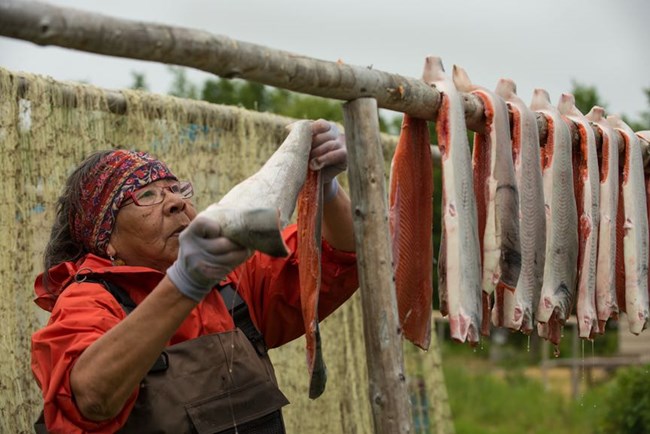
NPS Photo
The Alaska National Interest Lands Conservation Act (ANILCA) of 1980 recognizes the importance of subsistence to rural Alaska residents. It also recognizes the importance of maintaining unspoiled ecosystems and healthy fish and wildlife populations. In fact, ANILCA views subsistence as an important part of the “natural and healthy” functioning of ecosystems. The subsistence way of life is one of the timeless values sustained by Alaska’s national park units.
NPS Subsistence Management in Alaska
ANILCA established many new parks, preserves, and monuments in Alaska and expanded some existing park units. Congress understood the importance of these lands to Alaska rural residents. They made sure that subsistence uses were allowed in nine of the new park units and in two of the existing areas. Congress also established a priority for subsistence. It states that subsistence uses of fish and wildlife shall be given priority over other uses of these resources. This is now commonly known as the “rural preference.”
ANILCA allows local rural residents to use fish, wildlife, plants and other wild renewable resources for subsistence on the following NPS-managed lands:
Providing opportunities for people to maintain a subsistence way of life is an important part of managing national park units in Alaska. It also requires close working relationships between the NPS and local rural residents.
Aniakchak National Monument and Preserve
Cape Krusenstern National Monument
Bering Land Bridge National Preserve
Denali National Preserve and the ANILCA addition to Denali National Park
Yukon-Charley Rivers National Preserve
Lake Clark National Park and Preserve
To help build those relationships ANILCA requires the NPS to establish subsistence resource commissions (SRCs) in parks and monuments where subsistence is allowed. These SRCs serve as a direct link between subsistence users and NPS managers. They provide a source of local knowledge and guidance about the subsistence needs and practices of rural people. They also provide feedback on potential changes to subsistence regulations and other subsistence-related issues affecting lands managed by the NPS.

USFWS photo
The Federal Subsistence Management Program is unique. Nowhere else in the United States is there a similar program to manage subsistence use of fish and wildlife on federal public lands. Likewise, the program is unique for the NPS. The NPS participates in the Federal Subsistence Management Program to make decisions on subsistence hunting, trapping and fishing on federally managed lands in Alaska —including lands managed by the NPS.
The Federal Subsistence Program is under the direction of the Secretaries of the Interior and Agriculture in Washington, D.C. The Secretaries have delegated the management of fish and wildlife resources for subsistence uses on federal public lands in Alaska to the Federal Subsistence Board.
The Federal Subsistence Board (FSB) is the decision-making body that oversees the Federal Subsistence Management Program. It is made up of the regional directors, or their representatives, of the U.S. Fish and Wildlife Service, Bureau of Land Management, National Park Service, Bureau of Indian Affairs and U.S. Forest Service. The FSB also includes two public members who possess personal knowledge of and direct experience with subsistence use in rural Alaska. A representative appointed by the Secretaries serves as the Board Chair.
Ten regional advisory councils (RACs) representing 10 geographic areas of Alaska provide input to the Federal Subsistence Program. The RACs make recommendations on proposals to change subsistence regulations and on other subsistence-related issues. The RACs actively seek input and recommendations from SRCs on subsistence issues related to specific park and monument areas. The SRCs are a critical link between local rural residents who rely on park and monument resources for subsistence and the larger Federal Subsistence Management Program.
The U.S. Fish and Wildlife Service Office of Subsistence Management (OSM) is the lead administrative office for the Federal Subsistence Management Program and provides staff support to the FSB and RACs.
Last updated: April 14, 2017
